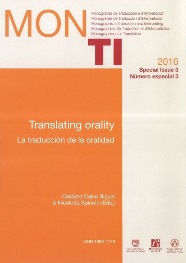Orality and gender: a corpus-based study on lexical patterns in simultaneous interpreting
##plugins.themes.bootstrap3.article.main##
Resum
Descàrregues
##plugins.themes.bootstrap3.article.details##
La propietat intel·lectual dels articles pertany als autors i els drets d'edició i publicació, a la revista. Els articles publicats en la revista podran ser utilitzats lliurement per a propòsits educatius i científics, sempre que se'n faça una correcta citació. Qualsevol ús comercial és expressament penat per la llei.
Referències
Bergvall, Victoria; Janet M. Bing & Alice F. Freed (eds.) (1996) Rethinking Language and Gender Research. Theory and Practice. New York: Addison Wesley Longman.
Bergvall, Victoria; Janet M. Bing & Alice F. Freed. (2011) “Rethinking Language and Gender Research. Theory and Practice.” In: Wodak, Ruth; Barbara Johnstone & Paul E. Kerswill (eds.) The Sage Handbook of Sociolinguistics. London: Sage, pp. 411-423.
Castello, Erik. (2004) “Calcolo della densità lessicale e dell’intricatezza grammaticale di corpora linguistici.” In: Taylor Torsello, Carol; Maria Grazia Busà & Sara Gesuato (eds.) Lingua Inglese e Mediazione Interlinguistica. Ricerca e didattica con supporto telematico. Padua: Unipress, pp. 131-151.
Eckert, Penelope & Sally McConnell-Ginet. (1992) “Communities of practice: where language gender and power all alive.” In: Hall, Kira; Mary Buchholz & Birch Moonwoman (eds.) Locating power: proceedings of the second Berkeley women and language Conference. Berkeley: Berkeley Women and Language Group, University of California, pp. 89-99.
Freed, Alice F. (1996) “Language and gender research in an experimental setting.” In: Bergvall, Victoria et al. (eds.) Rethinking Language and Gender Research. Theory and Practice. New York: Addison Wesley Longman, pp. 54-76.
García Mouton, Pilar. (1999) Cómo hablan las mujeres. Madrid: Arco/Libros.
Herring, Susan C. (1996) “Two variants of an electronic message schema.” In: Herring, Susan C. (ed.) Computer-Mediated Communication: Linguistic, Social & Cross- Cultural Perspectives. Amsterdam: John Benjamins, pp. 81-106.
Holmes, Janet. (1990) “Hedges and boosters in women’s and men’s speech.” Language and Communication 10:3, pp. 185-205.
Koppel, Moshe; Shlomo Argamon & Anat Rachel Shimoni. (2002) “Automatically categorizing written texts by author gender.” Literary and Linguistic Computing 17:4, pp. 401-412.
Labov, William. (1972) Sociolinguistic patterns. Philadelphia: University of Pennsylvania Press.
Labov, William. (1990) “The intersection of sex and social class in the course of linguistic change.” Language Variation and Change 2, pp. 205-254.
Lakoff, Robin. (1975) Language and woman’s place. New York: Harper & Row.
Laviosa, Sara. (1998) “Core patterns of lexical use in a comparable corpus of English narrative prose.” Meta 43:4, pp. 557-570.
López García, Ángel & Ricardo Morant. (1991) Grámatica femenina. Madrid: Cátedra.
Mikros, George. (2013) “Systematic stylometric differences in men and women authors: a corpus-based study.” In: Köhler, Reinhard & Gabriel Altmann (eds.) Issues in Quantitative Linguistics 3. Dedicated to Karl-Heinz Best on the occasion of his 70th birthday. Lüdenscheid: RAM, pp. 206-223. Electronic version: http://users.uoa.gr/~gmikros/Pdf/Systematic%20stylometric%20differences%20in%20men%20and%20women%20authors.pdf
Monti, Cristina; Claudio Bendazzoli; Annalisa Sandrelli & Mariachiara Russo. (2005) “Studying directionality in simultaneous interpreting through an electronic corpus: EPIC (European Parliament Interpreting Corpus).” Meta 50:4. Electronic version: http://www.erudit.org/revue/meta/2005/v/n4/019850ar.html
Muchnik, Malka. (1997) “Men vs. women – Different communication patterns.” Hebrew Linguistics 41-42, pp. 79-86.
Mulac, Anthony; Lisa B. Studley & Sheridan Blau. (1990) “The gender-linked language effect in primary and secondary students’ impromptu essays.” Sex Roles 23:9-10, pp. 439- 469.
Russo, Mariachiara; Claudio Bendazzoli & Annalisa Sandrelli. (2006) “Looking for lexical patterns in a trilingual corpus of source and interpreted speeches: extended analysis of EPIC (European Parliament Interpreting Corpus).” FORUM, International journal of interpretation and translation, 4:1, pp. 221-254.
Russo, Mariachiara; Claudio Bendazzoli; Annalisa Sandrelli & Nicoletta Spinolo. (2012) “The European Parliament Interpreting Corpus (EPIC): implementation and developments.” In: Straniero Sergio, Francesco & Caterina Falbo (eds.) Breaking Ground in Corpus-Based Interpreting Studies. Bern: Peter Lang, pp. 53-90.
Russo, Mariachiara. (forthcoming) “Speech patterns and gender: trends emerging from Epic.” Paper presented at The Forlì First international workshop Corpusbased interpreting studies: the State of the Art, Forlì 7-8 May 2015.
Sandrelli, Annalisa & Claudio Bendazzoli. (2005) “Lexical Patterns in Simultaneous Interpreting a Preliminary Investigation of EPIC (European Parliament Interpreting Corpus).” Proceedings from the Corpus Linguistics Conference Series, 1(1). Electronic version: http://www.birmingham.ac.uk/research/activity/corpus/publications/conference-archives/2005-conf-e-journal.aspx
Sandrelli, Annalisa; Claudio Bendazzoli & Mariachiara Russo. (2010) “European Parliament Interpreting Corpus (EPIC): Methodological issues and preliminary results on lexical patterns in SI.” International Journal of Translation 22:1-2, pp. 165-203.
Shlesinger, Miriam. (2009) “Towards a definition of Interpretese: An intermodal, corpus-based study.” In: Hansen, Gyde; Andrew Chesterman & Heidrun Gerzymisch-Arbogast (eds.) Efforts and Models in Interpreting and Translation Research. A tribute to Daniel Gile. Amsterdam & New York: John Benjamins, pp. 237-253.
Shlesinger, Miriam; Moshe Koppel; Noam Ordan & Brenda Malkiel. (2009)
“Markers of translator gender: do they really matter?” Copenhagen Studies in Language 38, pp. 138-198. Electronic version: http://u.cs.biu.ac.il/~koppel/papers/Shlesinger%20et%20al_183-198.pdf
Tannen, Deborah. (1990) You just don’t understand. Women and Men in conversation. New York: William Morrow.
Tannen, Deborah. (1994) Gender and Discourse. New York & Oxford: Oxford University Press.


